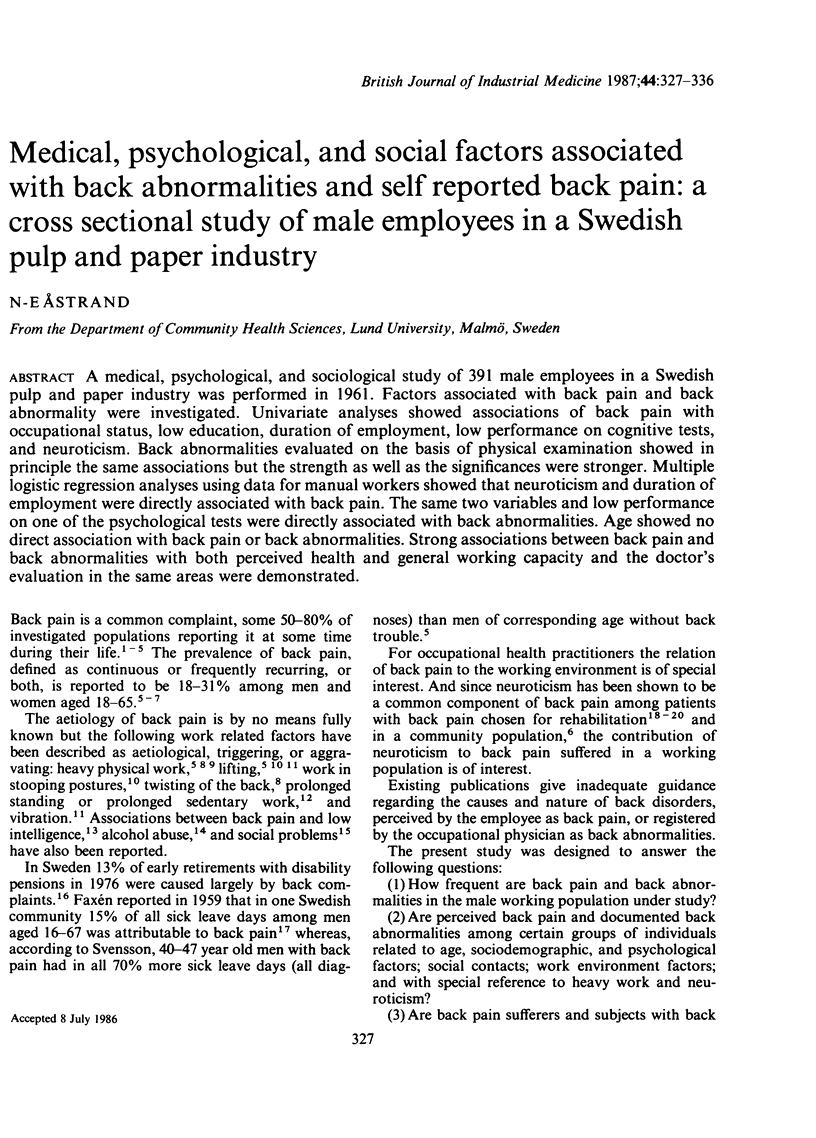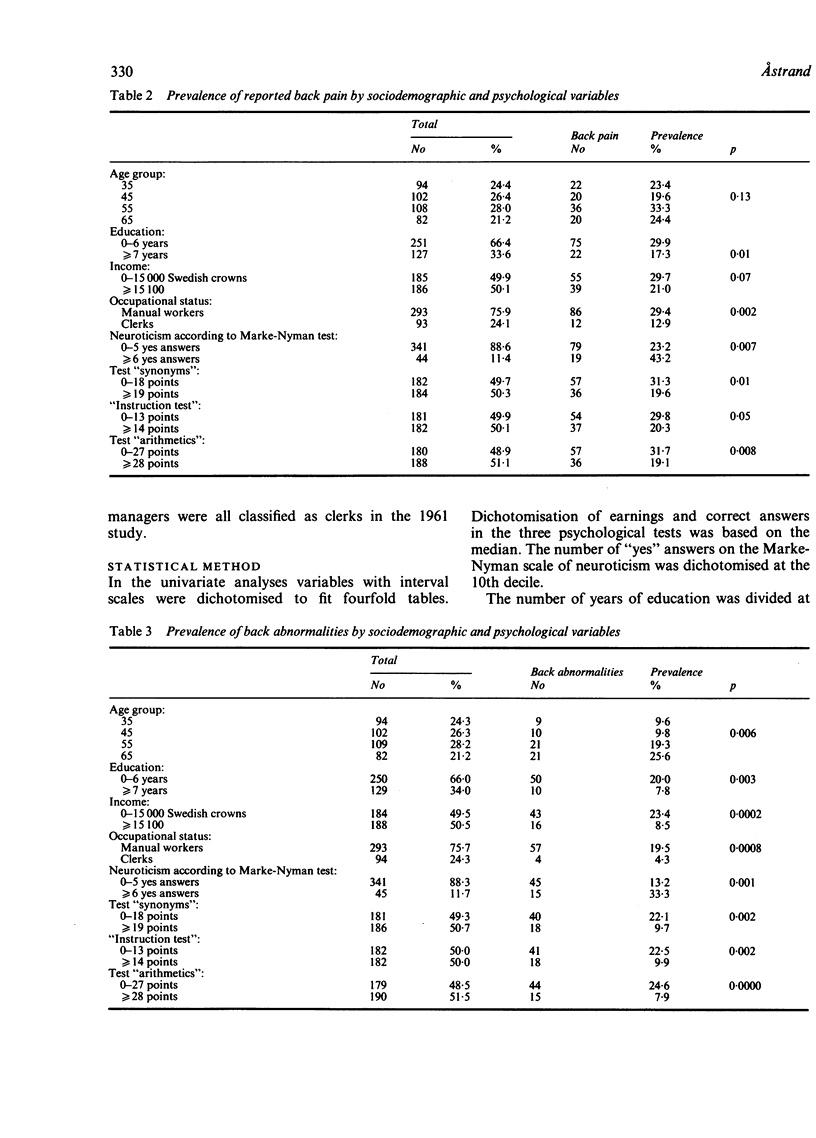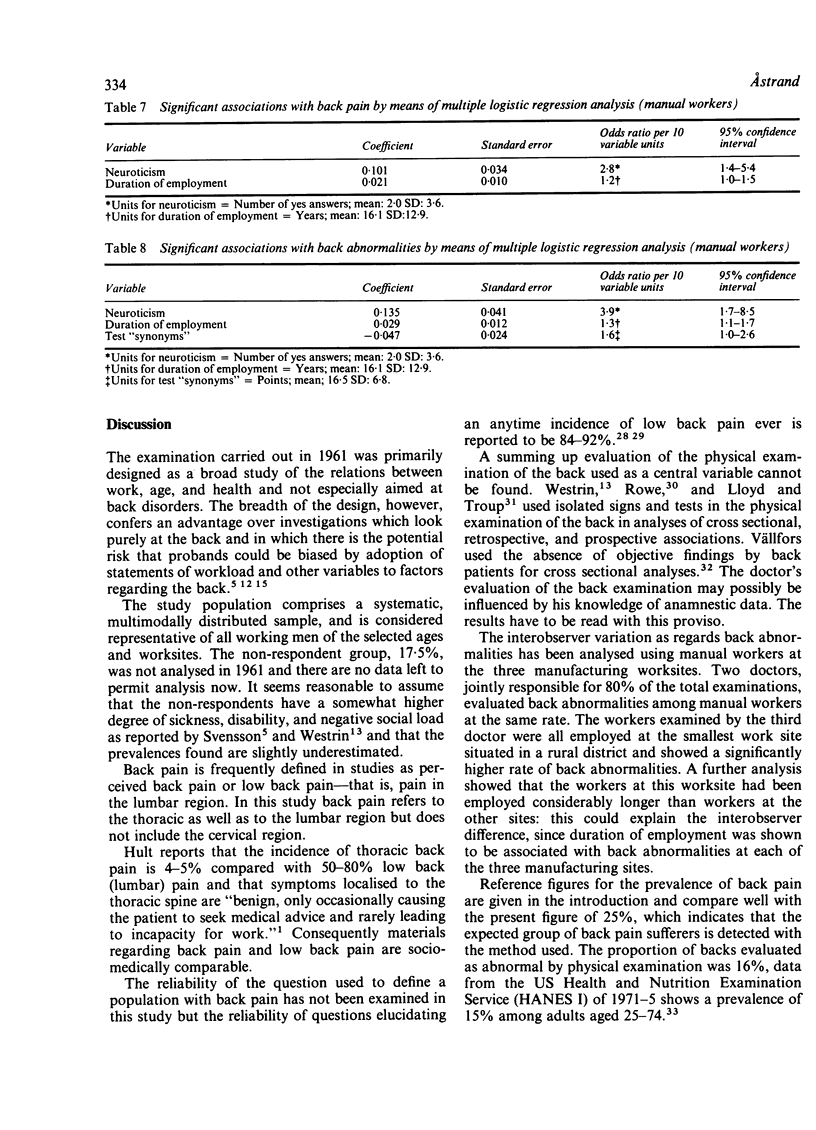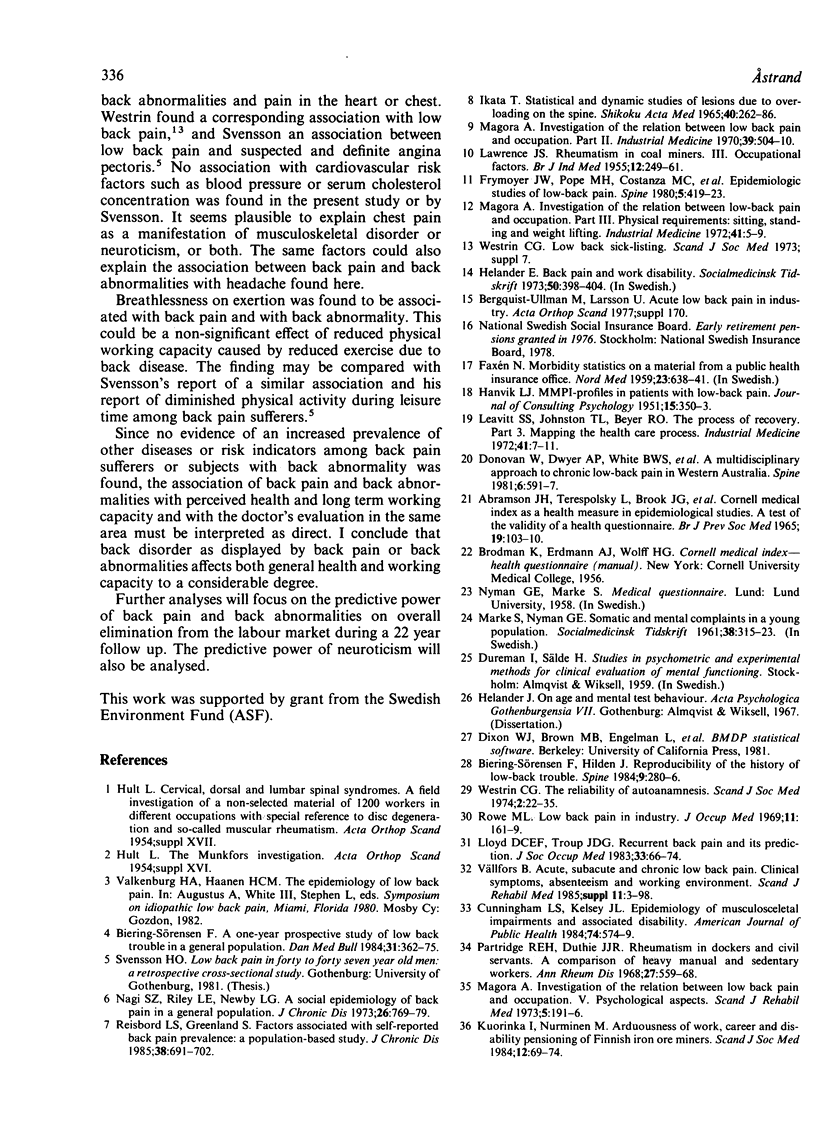Abstract
A medical, psychological, and sociological study of 391 male employees in a Swedish pulp and paper industry was performed in 1961. Factors associated with back pain and back abnormality were investigated. Univariate analyses showed associations of back pain with occupational status, low education, duration of employment, low performance on cognitive tests, and neuroticism. Back abnormalities evaluated on the basis of physical examination showed in principle the same associations but the strength as well as the significances were stronger. Multiple logistic regression analyses using data for manual workers showed that neuroticism and duration of employment were directly associated with back pain. The same two variables and low performance on one of the psychological tests were directly associated with back abnormalities. Age showed no direct association with back pain or back abnormalities. Strong associations between back pain and back abnormalities with both perceived health and general working capacity and the doctor's evaluation in the same areas were demonstrated.
Full text
PDF









Selected References
These references are in PubMed. This may not be the complete list of references from this article.
- Abramson J. H., Terespolsky L., Brook J. G., Kark S. L. Cornell Medical Index as a health measure in epidemiological studies. A test of the validity of a health questionnaire. Br J Prev Soc Med. 1965 Jul;19(3):103–110. doi: 10.1136/jech.19.3.103. [DOI] [PMC free article] [PubMed] [Google Scholar]
- Biering-Sørensen F. A one-year prospective study of low back trouble in a general population. The prognostic value of low back history and physical measurements. Dan Med Bull. 1984 Oct;31(5):362–375. [PubMed] [Google Scholar]
- Biering-Sørensen F., Hilden J. Reproducibility of the history of low-back trouble. Spine (Phila Pa 1976) 1984 Apr;9(3):280–286. doi: 10.1097/00007632-198404000-00010. [DOI] [PubMed] [Google Scholar]
- Cunningham L. S., Kelsey J. L. Epidemiology of musculoskeletal impairments and associated disability. Am J Public Health. 1984 Jun;74(6):574–579. doi: 10.2105/ajph.74.6.574. [DOI] [PMC free article] [PubMed] [Google Scholar]
- Donovan W. H., Dwyer A. P., White B. W., Batalin N. J., Skerritt P. W., Bedbrook G. M. A multidisciplinary approach to chronic low-back pain in Western Australia. Spine (Phila Pa 1976) 1981 Nov-Dec;6(6):591–597. doi: 10.1097/00007632-198111000-00010. [DOI] [PubMed] [Google Scholar]
- FAXEN N. Morbiditetsstastistik pá sjukkassematerial. Nord Med. 1959 Mar 23;61(17):638–641. [PubMed] [Google Scholar]
- Frymoyer J. W., Pope M. H., Costanza M. C., Rosen J. C., Goggin J. E., Wilder D. G. Epidemiologic studies of low-back pain. Spine (Phila Pa 1976) 1980 Sep-Oct;5(5):419–423. doi: 10.1097/00007632-198009000-00005. [DOI] [PubMed] [Google Scholar]
- HANVIK L. J. MMPI profiles in patients with low-back pain. J Consult Psychol. 1951 Aug;15(4):350–353. doi: 10.1037/h0058656. [DOI] [PubMed] [Google Scholar]
- LAWRENCE J. S. Rheumatism in coal miners. III. Occupational factors. Br J Ind Med. 1955 Jul;12(3):249–261. doi: 10.1136/oem.12.3.249. [DOI] [PMC free article] [PubMed] [Google Scholar]
- Leavitt S. S., Johnston T. L., Beyer R. D. The process of recovery: patterns in industrial back injury. 3. Mapping the health care process. IMS Ind Med Surg. 1972 Jan;41(1):7–11. [PubMed] [Google Scholar]
- Lloyd D. C., Troup J. D. Recurrent back pain and its prediction. J Soc Occup Med. 1983 Apr;33(2):66–74. doi: 10.1093/occmed/33.2.66. [DOI] [PubMed] [Google Scholar]
- MARKE S., NYMAN G. E. [Somatic and mental complaints in a group of normal young persons. Analysis of a medical survey]. Soc Med Tidskr. 1961 Oct;38:315–323. [PubMed] [Google Scholar]
- Magora A. Investigation of the relation between low back pain and occupation. 3. Physical requirements: sitting, standing and weight lifting. IMS Ind Med Surg. 1972 Dec;41(12):5–9. [PubMed] [Google Scholar]
- Magora A. Investigation of the relation between low back pain and occupation. V. Psychological aspects. Scand J Rehabil Med. 1973;5(4):191–196. [PubMed] [Google Scholar]
- Partridge R. E., Duthie J. J. Rheumatism in dockers and civil servants. A comparison of heavy manual and sedentary workers. Ann Rheum Dis. 1968 Nov;27(6):559–568. doi: 10.1136/ard.27.6.559. [DOI] [PMC free article] [PubMed] [Google Scholar]
- Rowe M. L. Low back pain in industry. A position paper. J Occup Med. 1969 Apr;11(4):161–169. doi: 10.1097/00043764-196904000-00001. [DOI] [PubMed] [Google Scholar]
- Westrin C. G. The reliability of auto-anamnesis. A study of statements regarding low back trouble. Scand J Soc Med. 1974;2(1):23–35. doi: 10.1177/140349487400200104. [DOI] [PubMed] [Google Scholar]


